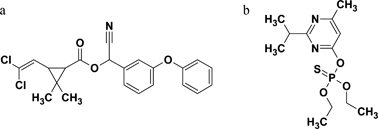Development of microbial degradation of cypermethrin and diazinon in organically and conventionally managed soils†
Abstract
The behaviour of

* Corresponding authors
a
Department of Environmental Science, Faculty of Science and Technology, Lancaster University, Lancaster, UK
E-mail:
k.semple@lancaster.ac.uk (K.T. Semple)
Fax: +44 1524 593985
Tel: +44 1524 594534
The behaviour of

 Please wait while we load your content...
Something went wrong. Try again?
Please wait while we load your content...
Something went wrong. Try again?
K. A. Fenlon, K. C. Jones and K. T. Semple, J. Environ. Monit., 2007, 9, 510 DOI: 10.1039/B700668C
To request permission to reproduce material from this article, please go to the Copyright Clearance Center request page.
If you are an author contributing to an RSC publication, you do not need to request permission provided correct acknowledgement is given.
If you are the author of this article, you do not need to request permission to reproduce figures and diagrams provided correct acknowledgement is given. If you want to reproduce the whole article in a third-party publication (excluding your thesis/dissertation for which permission is not required) please go to the Copyright Clearance Center request page.
Read more about how to correctly acknowledge RSC content.
 Fetching data from CrossRef.
Fetching data from CrossRef.
This may take some time to load.
Loading related content
